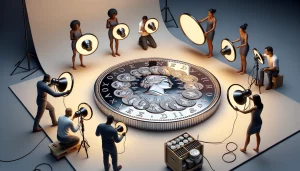Why Photographing Your Coin Collection Matters for Insurance
Protect Your Treasure Trove
Imagine this: your carefully curated coin collection, built with passion over years, falls victim to an unexpected disaster—fire, theft, or some other misfortune. How do you prove its worth when it matters most? Capturing crisp, detailed images of your coins isn’t just a task; it’s your safety net, your invisible shield that ensures you can recover their value through insurance claims. After all, your collection isn’t just shiny metal—it’s history in your hands, and it deserves protection like the rare treasure it truly is.
Clarity Means Credibility
Insurance companies need evidence. A description alone might leave too much room for doubt, but a photograph tells the full story. Picture this: a 1907 Saint-Gaudens Double Eagle coin. Without a photo, who’s to say it’s not a replica? When you provide clear photos documenting every angle, subtle details like mint marks, wear, and patina are impossible to debate.
Why photographing your coins makes all the difference:
- You create a visual inventory of your collection. No mental gymnastics required in emergencies.
- Comprehensive proof bolsters your case during claims disputes.
- It simplifies the valuation process—your insurer sees what you see.
Not snapping those photos? That’s gambling with years of your effort and investment. Your coins deserve better.
Essential Equipment for Capturing High-Quality Images

Lighting: Your Secret Weapon for Stunning Coin Photos
Let’s face it—coins are notoriously tricky to photograph. They reflect light like mirrors and hide details in shadows. That’s why excellent lighting is your best friend. A ring light or softbox diffuser can create even, shadow-free illumination that makes every intricate detail pop. Avoid overhead lights—they’ll just throw glares all over the place. Natural light? Sure, but only if you have a cloudy day or access to bright, indirect sunlight.
For those needing precision, consider a portable LED photography light. These gems let you adjust brightness and even color temperature so you can highlight patinas or inscriptions without distortion. Think of it as painting with light, bringing your coins’ story to life.
Tools That Bring Sharpness & Detail into Focus
You wouldn’t sketch a masterpiece with a broken pencil, right? The same goes for photographing coins. A quality camera or smartphone with high resolution is a must, but don’t stop there. Equip yourself with these essentials:
- Macro lenses: Give your lens superhero vision to capture up-close, jaw-dropping detail.
- Tripods: Keep things steady while aiming for that tight shot—blur is your worst enemy here.
- Remote shutter release: Perfect for snapping pics without nudging your setup, ensuring razor-sharp focus.
The goal? Freeze time and immortalize your prized collection with precision, clarity, and personality.
Tips and Techniques for Photographing Coins Effectively

Mastering Lighting for Coin Photography
When it comes to photographing coins, your best friend—and sometimes your worst enemy—is lighting. Coins, with their intricate designs and reflective surfaces, are like little mirrors begging for the right light to truly shine. Skip the flash! A camera’s flash will blow out details and create harsh glares. Instead, use soft, diffused light—think natural daylight coming through a white curtain or a simple desk lamp covered with a piece of parchment paper. Trust me, this one tweak can transform your images.
Pay attention to shadows too—they’re sneaky! Hold the coin slightly tilted to reveal depth without creating dark pools that swallow up those beautiful engravings. Play around with angles until you strike gold (pun intended).
Framing and Backgrounds That Make Coins Pop
Imagine this: a stunning 1851 Liberty Head Double Eagle photographed against…a distracting paisley tablecloth. Yikes! Keep backgrounds plain, clean, and non-reflective—black velvet or white foam board work wonders.
And don’t just snap coins directly from above. Get creative! Use a low-angle close-up or tilt slightly to highlight the edge reeding. And hey, nobody’s judging if you take a few dozen test shots. The beauty is in the details!
- Use a tripod to eliminate shaky hands and blurry edges.
- Employ macro mode on your camera or smartphone for sharp focus.
- Capture both obverse and reverse sides to document every inch.
Organizing and Cataloging Photos for Insurance Documentation

Give Each Photo a Story
Organizing your coin photos isn’t just about ticking boxes; it’s about giving each treasure its rightful pedestal. Imagine flipping through an album where every image exudes clarity and detail, instantly telling the story of your collection. Here’s how to achieve that level of perfection.
Start by creating a structure that makes sense to *you*. Whether it’s chronological, by coin type, or even sentimental value, let your system reflect your passion. For each photograph, label the file with thoughtful details—coin name, year, mint mark, and condition. For example, instead of “IMG_001.jpg,” go for something like “1921_PeaceDollar_MS65.jpg.” It’s like naming characters in a novel; boring names won’t do justice.
- Create folders: Categorize by denomination, region, or even purchase date.
- Use backup tools: Cloud storage, external drives, or both. Redundancy is insurance’s best friend.
Turn Chaos into a Digital Museum
Consider adding a document or spreadsheet alongside your images. This extra step bridges the gap between photo and context. Note details like the coin’s provenance or latest appraisal. Suddenly, your digital gallery transforms into a museum catalog—rich, reliable, and ready to wow both insurers and future you.
Ensuring Insurance Acceptance of Your Coin Photos

What Insurance Companies Really Want
When it comes to insuring your prized coin collection, not all photographs are created equal. To an insurance company, your photos aren’t just pretty pictures—they’re legal proof of value. Think of them as the lifeline between your collection and a successful claim. But how do you ensure your photos don’t end up in some rejected pile?
First, make sure your images show not just beauty, but *clarity*. Every detail counts. Do your coins sparkle in high definition? Can someone see the glint of a mint mark on a 1909-S VDB Lincoln penny? These features affect value, and insurers love precision.
- Include close-ups of each coin’s condition: scratches, patina, and any unique marks.
- Photograph the obverse (heads) and reverse (tails)—both sides tell the full story.
- Don’t forget the grade! If a coin is certified, capture the slab with its label clearly visible.
The Devil Is in the Documentation
Your photos are only as good as their context. Pairing them with detailed cataloging will make your insurer smile. Label those images with specific information like year, mint, denomination, and grade. Insurers eat up that level of detail because it leaves no room for ambiguity.
Keep everything digital, organized, and backed up. A zipped folder stored both in the cloud and on a secure drive could be your ultimate safety net. Picture this: if disaster hits, you’ll have the satisfaction of knowing your collection’s true value is protected.












